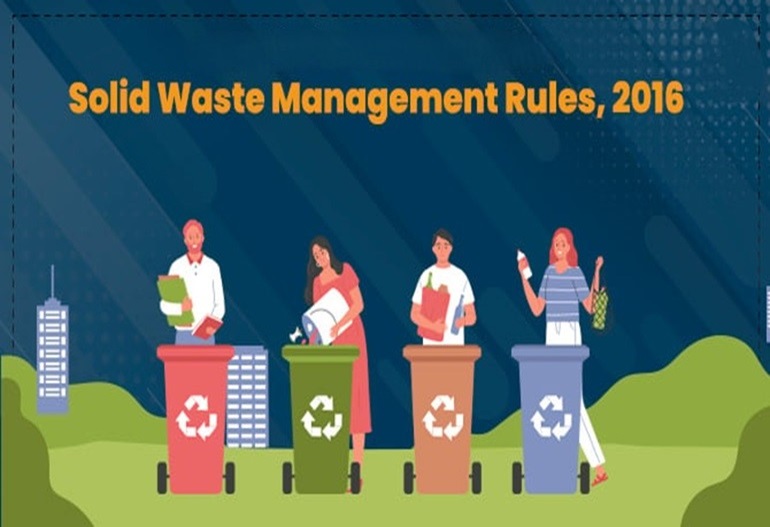Solid Waste Management Rules 2016: Provisions, Roles, and Impact in India
Solid waste management has always been a pressing challenge in India, given the growing population, urbanization, and industrial expansion. To address these issues, the Solid Waste Management Rules, 2016 were notified by the Ministry of Environment, Forest and Climate Change (MoEFCC). These rules replaced the Municipal Solid Waste Rules, 2000, making them more comprehensive and inclusive.
The 2016 rules mark a significant step in ensuring scientific waste management, citizen participation, and extended responsibility for various stakeholders.
Why Solid Waste Management Rules 2016 Were Introduced?
The earlier framework under the 2000 rules had limited scope and did not cover many waste generators. By 2016, India was generating more than 62 million tonnes of waste annually, of which only 70% was collected and less than 25% was scientifically processed.
Thus, the SWM Rules 2016 were designed to:
• Expand coverage beyond municipal areas.
• Ensure segregation at source.
• Assign responsibility to producers, brand owners, institutions, vendors, and citizens.
• Promote scientific processing and recycling.
Key Provisions of Solid Waste Management Rules 2016
1. Wider Applicability
The rules now apply to:➤ Urban and rural areas
➤ Census towns
➤ SEZs (Special Economic Zones)
➤ Industrial townships
➤ Ports, airports, and railway stations
2. Segregation at Source
Waste generators must segregate waste into:➤ Biodegradable waste
➤ Dry waste (plastic, paper, metals, glass)
➤ Domestic hazardous waste (diapers, sanitary waste, chemicals, e-waste)
3. Duties of Local Bodies
Urban Local Bodies (ULBs) must:➤ Collect, transport, and process segregated waste.
➤ Establish infrastructure for composting, biomethanation, and waste-to-energy plants.
➤ Ensure scientific landfill management.
4. Role of Waste Generators
➤ Households, institutions, and offices must segregate waste at source.➤ Large waste generators like hotels, marriage halls, and industrial units must manage their waste in-house.
➤ Spot fines and penalties are applicable for non-compliance.
5. Extended Producer Responsibility (EPR)
Brand owners, manufacturers, and producers of plastic packaging must:➤ Collect back the waste generated from their products.
➤ Implement recycling or disposal mechanisms.
➤ Work with local authorities for efficient collection systems.
6. Inclusion of Ragpickers and Waste Pickers
For the first time, the rules recognized the contribution of the informal sector. Local bodies are directed to:➤ Integrate waste pickers into the formal waste management system.
➤ Provide training, protective gear, and social security measures.
7. Waste Processing Targets
➤ Biodegradable waste → composting or biomethanation.➤ Non-biodegradable waste → recycling or energy recovery.
➤ Landfilling allowed only for inert waste or residues.
8. Responsibilities of State Governments
➤ Prepare annual reports.➤ Monitor implementation.
➤ Set up waste processing plants and close open dumps.
9. Role of Street Vendors and Market Associations
The Solid Waste Management Rules 2016 also addressed waste generated in markets, streets, and vending areas.• Street vendors must:
➤ Keep suitable containers/bins for storage of waste at the place of vending.
➤ Ensure segregation of waste (biodegradable, dry, hazardous) at source.
➤ Deposit collected waste to the nearest collection point, as notified by the local authority. • Market associations & shopkeepers must:
➤ Provide community bins for waste storage.
➤ Ensure that waste is not littered on roads or open spaces.
➤ Collaborate with local bodies for waste management.
Impact of Solid Waste Management Rules 2016
Since implementation, the rules have:
• Improved awareness about segregation at source.
• Boosted the use of composting and waste-to-energy plants.
• Encouraged corporate responsibility through EPR.
• Reduced reliance on landfills in many urban areas.
Challenges in Implementation
• Lack of strict enforcement by municipalities.• Limited infrastructure for processing and recycling.
• Low citizen participation in segregation.
• Informal sector still largely unorganized.
Final Thoughts
The Solid Waste Management Rules, 2016 are a landmark reform in India’s journey toward sustainable waste management. By promoting segregation, recycling, and shared responsibility, these rules provide a roadmap for a cleaner and greener India.
To achieve their true potential, strong enforcement, awareness campaigns, vendor participation, and citizen involvement are essential. Together, these efforts can significantly reduce waste pollution and contribute to a sustainable future.









Get In Touch
Plot No. 81, Sector 05, IMT Manesar, Gurgaon, 122051
info@kirimawasu.com
+91 98122 41001
Quick Links
© kirimawasu. All Rights Reserved.



